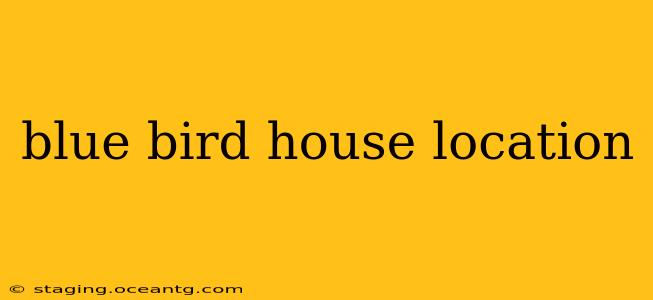Bluebirds, with their vibrant plumage and cheerful songs, are a welcome addition to any garden. Attracting these beautiful birds requires more than just a birdhouse; it necessitates careful consideration of location. Placing your bluebird house strategically maximizes your chances of a successful nesting season. This guide will help you find the perfect spot, answering common questions about bluebird house placement.
What are the best locations to put a bluebird house?
The ideal location for a bluebird house balances safety from predators, access to food and water, and a comfortable environment for the birds. Bluebirds prefer open areas with short grass or sparsely vegetated land. They need a clear flight path to and from the house, free from dense shrubs or tall grass that could conceal predators. Ideally, the house should be positioned in a sunny spot, but with some protection from harsh weather.
How high should a bluebird house be?
Bluebird houses are typically mounted between 4 and 6 feet above the ground. This height provides sufficient protection from ground predators like raccoons and snakes, while still allowing easy access for the birds. Avoid placing the house too high, as this can make it more difficult for the birds to monitor their surroundings and defend against aerial predators.
Should I put a bluebird house near a tree?
While proximity to trees can offer some natural cover, it's crucial to avoid placing the house directly on a tree trunk or in dense overhanging branches. This could attract predators like cats and snakes. Instead, position the house in an open area, perhaps a few feet from a tree or a post, for a compromise between visibility and protection.
What direction should a bluebird house face?
Ideally, the entrance hole should face away from prevailing winds and direct, intense sunlight. An east or southeast facing orientation is often preferred. This provides morning sun for warmth and some protection from harsh afternoon heat. However, the specific ideal orientation may depend on your local climate and prevailing weather patterns.
How far apart should bluebird houses be?
Bluebirds are territorial, so it’s essential to maintain sufficient distance between houses. Spacing houses at least 100 yards (approximately 90 meters) apart helps minimize competition and territorial disputes. If you plan on installing multiple houses, consider the available foraging habitat to ensure there’s enough food and resources to support the birds.
What are the best trees to put a bluebird house near?
The type of tree near your bluebird house is less important than the overall location. Focus on open areas with short grass rather than selecting a specific species of tree. Overhanging branches should be avoided, as they can provide cover for predators.
Can I put a bluebird house near a bird feeder?
Positioning a birdhouse near a bird feeder can be beneficial, providing a convenient food source for the adults raising young. However, keep in mind that an overcrowded feeding area could also attract more predators. Ensure the feeder is placed strategically to minimize this risk.
By considering these factors and carefully selecting the location of your bluebird house, you significantly increase the chances of attracting these beautiful birds and enjoying their presence in your garden. Remember that patience is key; it may take time for bluebirds to discover and utilize your new house. Happy birdwatching!
